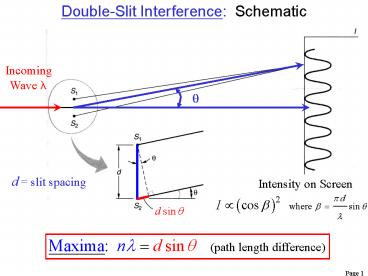DoubleSlit Interference: Schematic - PowerPoint PPT Presentation
1 / 13
Title:
DoubleSlit Interference: Schematic
Description:
Blackbody Spectrum: Rayleigh-Jeans Equation ... Limit for large l Raleigh-Jeans. ... distribution f(E) and integrates to find Eave for the Raleigh-Jeans equation. ... – PowerPoint PPT presentation
Number of Views:94
Avg rating:3.0/5.0
Title: DoubleSlit Interference: Schematic
1
Double-Slit Interference Schematic
Incoming Wave l
q
d slit spacing
Intensity on Screen
2
Photons Wave-like Behavior
- de Broglie (1924) proposed that ALL particles
(photon, electron, atoms, etc.) have an
associated wavelength l h/p. - Proof for photon (zero mass) given by
Rest mass
From Relativity
For a Photon (m 0)
3
Momentum and Energy Get it Right!
- Momentum and Energy DEFINITIONS
- Energy vs. Momentum RELATIONSHIPS
4
Electrons Wave-like Behavior
- Every particle has a wavelength given by
- Question Why are there no observed effects of
particle waves (i.e., diffraction and
interference) in day-to-day life? - Answer Macroscopic objects have wavelengths too
small to interact with slits, BUT atomic-sized
objects DO appear to behave like waves!
Macroscopic Object ping pong ball
Microscopic Object slow electron (1 speed of
light)
5
Electrons Wave-like Behavior
- Evidence for wave-like behavior of electrons
includes - Diffraction/interference patterns formed by one
or more electrons passing through micromachined
slits (see below). - Diffraction patterns formed by a low energy
electron beam impinging on periodic atomic
lattice of a crystal surface (LEED).
Double-Slit Electron Diffraction Pattern
- Each dot indicates electron hitting a screen
located past the slit. - Dot locations are determined by a probabilistic
process, where multiple electrons build up the
diffraction pattern normally observed for light.
6
Electron Diffraction Shortcut l Calculation
- For LEED experiments, the electron wavelength l
must be known.
- For accelerating voltage Vo 100 V, l 0.12 nm
(atomic spacing).
7
Photons Electromagnetic Spectrum
400 nm
Gamma Rays
X-Rays
Ultraviolet
Visible Spectrum
Visible
Frequency
Wavelength
Infrared
Microwave
Short Radio Waves
TV and FM Radio
AM Radio
Long Radio Waves
700 nm
8
Blackbody Radiation Photons from hot object
- Temperature of a body is proportional to its
average translational kinetic energy. - Emitted Energy Thermal Radiation (red 500 oC)
- Increasing Temp Energy (or photons) absorbed via
oscillating atoms. - Decreasing Temp Energy emitted via oscillating
electrons. - Constant Temp Equal rates of energy absorption
and emission - Ideal Blackbody absorbs ALL incident radiation
and re-emits it.
Ideal Blackbody
Only absorbed and emitted radiation, no reflected
radiation
9
Blackbody Radiation Stefan-Boltzmann Relation
- R Radiation intensity, T Temp. in Kelvin, s
5.6710-8 W/m2K4 - For non-ideal black body, R sT4E where E
emissivity lt 1.
Experimental Spectral Distribution
Long l
Short l
10
Blackbody Radiation Wiens Law
Lower Temps
Spectral Distribution depends ONLY on Temperature.
Sunlight
11
Blackbody Spectrum Rayleigh-Jeans Equation
where Eave average energy per mode kT from
Boltzmann distribution n(l) number
of oscillation modes of cavity
Rayleigh-Jeans
- Raleigh-Jeans equation behaves well at long l
(low energy). - BUT, explodes to infinity for short l (high
energy).? UV catastrophe!
experiment
12
Blackbody Spectrum Plancks Law
where Eave is given by Bose-Einstein distribution
using E hc/l
- Plancks Law was initially found empirically
(trial and error!) - Derived from quantization of radiation, i.e.
existence of photons! - Limit for small l ? zero.Limit for large l ?
Raleigh-Jeans.
Rayleigh-Jeans
Plancks Law
13
Spectral Blackbody Derivation of Eave
- OLD method uses a continuous energy distribution
f(E) and integrates to find Eave for the
Raleigh-Jeans equation.
- NEW method uses a discrete energy distribution
fn(En) and uses a summation to find Eave for
Plancks Law.
- Assumption of Energy Quantization is CRITICAL!






























